Another action-packed year is coming to an end, and crypto investors can’t be more relieved. To say 2022 has been disastrous for the industry would be generous. We are getting through one of the worst years in crypto history.
At least once this year, most of us have wondered whether crypto still has what it takes to get back on its feet, let alone power a woke economy. In this article, we try to answer that question by analyzing the damage and the road ahead.
Crypto Recap 2022 — The Key Highlights
Thanks to some massive collapses, hacks, and regulator grips, crypto has shed a large share of its market cap to become an $857.53B economy (at the time of writing). It has tried investors – both seasoned and novice – who saw their portfolios burn down overnight. There were also events that reinstated faith in the blockchain industry, like the ETH Merge, crypto war donations, and crypto payment integrations.
Here is a quick look at the key crypto highlights of 2022 in chronological order.
1. Ottawa Protests & the Emergencies Act
The crypto industry was off to a slow start in 2022. The downturn that began in late 2021, in response to the unprecedented bull run in autumn, overstayed its welcome. Although the Canada Convoy protests – which led to the implementation of the Emergencies Act in February – didn’t lead to a quick bounce-back, drew more traction to the industry during this period.
To quell the protests, the Trudeau administration gave Canadian banks the authority to freeze accounts that support the protests without court orders. As people began to circumvent the order through cryptocurrencies, at least 34 different crypto wallets connected to the Freedom Convoy were blacklisted. The incident showed that centralized authorities can always rob citizens of their access to financial services if they dissent. It highlighted the relevance of cryptocurrencies and why it is integral to a democratic society.
Unlike fiat currency held by banks and centralized institutions, crypto savings can’t be seized because of your political leaning. It is safe with you, as long as you are the only person who has access to the wallet. That rules out centralized crypto exchanges from the equation, as proven by multiple cases of exchange hacks and mismanagement.
2. Crypto Donations Pour into Ukraine and Russia Adopts Crypto Payments
Russia invaded Ukraine on 24 February 2022, as the Russia-Ukrainian War that began in 2014 escalated. The Russia-Ukraine war and the subsequent energy crisis have taken a toll on the global economy this year, not sparing crypto. But it also went on to illustrate what the crypto industry is capable of.
The onset of the invasion which threw Ukraine into an economic stall saw crypto donations pour into the country from around the world. The Ukrainian government announced that it was open to crypto payments, to the pleasant shock of the community. Two wallet addresses requesting Bitcoin and Ethereum donations were shared along with the Tweet. Many, including Vitalik Buterin, raised suspicions of a Twitter hack after the pivotal announcement went live. The Government’s Ministry of Digital Transformation, however, confirmed that the announcement was official.
Soon after, the country witnessed a large influx of crypto donations – BTC, ETH, and other digital assets worth close to $30M – to fund its war relief efforts. Among the crypto donations were prominent NFTs, including CryptoPunks. Interestingly, the auction of a non-fungible token depicting the Ukraine flag raised 2,258 ETH, valued at around $6.75 million in an auction that ended on 2 March 2022.
The crisis didn’t just inspire Ukraine to embrace crypto. As sanctions brought the Russian economy to a halt and the value of the Ruble tumbled down, citizens turned to cryptocurrencies to send money across borders. At the same time, centralized crypto exchanges like Binance and Coinbase were under pressure to block Russian citizens.
3. Biden Issues Crypto Executive Order that was Long-Due
Crypto regulations have long stood in the way of the mass adoption of the industry. Unless governments and regulators take initiative to understand crypto and bring it under law, both citizens and businesses would hesitate to explore its potential. In March 2022, the US government took a solid step to regulate cryptocurrency and bring more clarity to the industry, under the helm of president Joe Biden.
The executive order directed federal agencies to create comprehensive plans for U.S. crypto regulation and enforcement. While hostile regulations have a history of triggering massive crypto crashes, like China’s crypto crackdown, pro-crypto regulations are always welcome. Although regulators are in no hurry, the executive order instills faith in the future of crypto.
4. Ronin Network Hack Drains $550M
The crypto industry has never run out of hacks and scams. Each year, dozens of exploits tarnish the industry’s image. The most interesting hack in 2022 was the nine-figure Ronin Network attack. Axie Infinity, one of the leading blockchain games of all time, lost its credibility in the event. AXS and SLP have tumbled down since then as players left the game in disappointment for better alternatives.
According to investigators, the hack was led by the North Korean state-sponsored Lazarus Group, which hacked into five of nine Ronin chain validators. The flimsy validation mechanism came crashing down, letting them steal around $551.8M.
Interestingly, nobody knew about the incident until six days later. The team remained unaware of the incident for almost a week, which exacerbated the situation. The incident was followed by more hacks led by the Lazarus Group attacks. In a similar phishing scheme, Layer 1 network Harmony lost $100M and DeFiance Capital founder Arthur Cheong lost coveted Azuki NFTs.
5. Terra Collapses After the UST De-Peg
The Terra meltdown was one of the biggest catastrophes to hit the crypto market in 2022. Terra, a high-cap crypto ecosystem, was known for its algorithmic stablecoin UST, backed by LUNA tokens. Unlike most stablecoins, UST was not fully collateralized by fiat currencies or cryptocurrencies. Instead, it used an algorithmic mechanism to tie the token price to the USD.
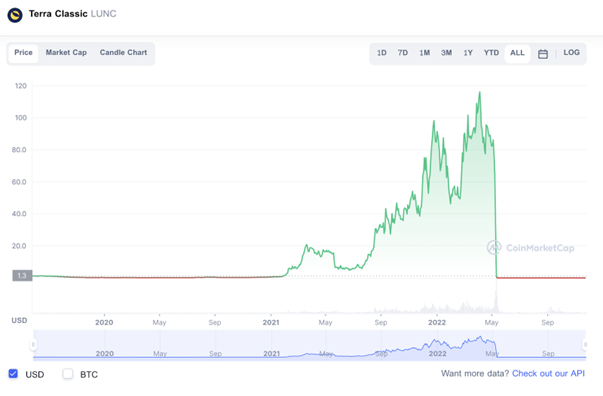
UST was one of the most preferred cryptocurrencies, as investors found refuge in stablecoins amid the long-drawn-out crypto winter from 2021. Another factor that sent the UST market cap and LUNA price soaring was Anchor Protocol. The lending platform built on Terra blockchain gave close to 20% yield to users who staked UST. As the stream of UST funds into Anchor increased, so did the number of LUNA that went into the burn wallet. Subsequently, the price of LUNA went higher and higher, leaving investors wondering if it was too good to be true. Most of the crypto market came crashing down with Terra, including blue-chip cryptos like Bitcoin and Ethereum, wiping out millions of dollars. The market didn’t show signs of recovery for a month.
6. Celsius Bankruptcy Triggers Chain Reaction
As the crypto market was slowly getting back on its feet, the next blow came on 12 June. The cryptocurrency lending company went down soon after it announced that it was placing withdrawals on hold. The market didn’t take the news well and tossed other crypto assets into a sea of red as well. The news that CEO Alex Mashinsky’s was engaged in unauthorized trading on the company’s books made the situation worse.
Soon after, the company was declared insolvent. The chain reaction sparked by the event continues to date. Platforms like Maker, Compound, and Aave and investment firms like Genesis, Galaxy Digital, and Three Arrows Capital which had lending relationships with Celsius took the brunt. The worst hit was Three Arrows, which also went down after allegedly defaulting on a series of loans worth $3.5B. The FTX collapse is also a consequence of the Celsius bankruptcy, in a way.
7. U.S. Treasury Bans Tornado Cash
After finding that Tornado Cash is used as a tool for money laundering, the U.S. Treasury’s Office of Foreign Assets Control put the privacy-preserving protocol on its sanctions list. Despite protests, both centralized and DeFi platforms were urged to blacklist wallets that used Tornado cash. Eventually, Netherlands’ Fiscal Information and Investigation Service arrested Tornado Cash core developer Alexey Pertsev.
The incident marked a black mark in crypto history, as this was the first time an authority sanctioned an open-source code instead of a platform. The event also raised concerns about the blockchain industry’s ability to withstand censorship. Does that mean the government has the power to halt decentralized projects as well? We will have to wait and see.
8. Ethereum Merge Revives Hope
The much-awaited Ethereum Merge was completed on September 15, which helped Ethereum reverse some of its losses in Aug this year. Although the Merge didn’t bring a widespread market boost as anticipated, it brought more clarity about the future of cryptocurrencies. As long as projects drive innovation and build value, the market will head north.
The Merge also went on to quell the criticisms of environmental impact against Ethereum, which was initially launched as a proof-of-work blockchain. The shift to proof-of-stake helped Ethereum improve its energy efficiency and mitigate its carbon footprint.
The weak price action was a result of the general bearish trends in the market. The relevance of The Merge will bring into light in the coming years as Ethereum acquires more integrations in the traditional space. ETH Merge has also improved Ethereum’s economics, as the network will be deflationary for a while.
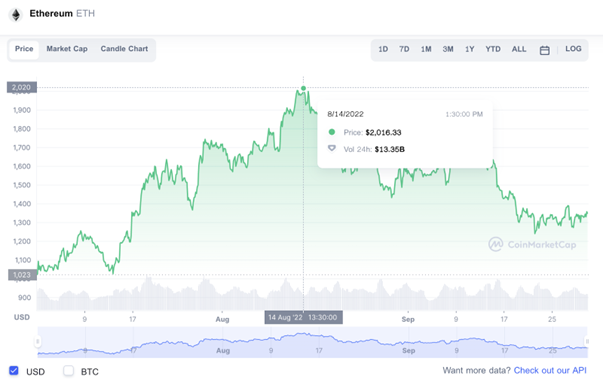
It also killed all suspicions of ‘ETH-killers’ actually killing the cryptocurrency, as the blockchain is at the forefront of the revolution with continuous dedication.
9. Twitter Acquisition Sends Meme Coins on a Bull Run
Elon Musk is a notable figure in the crypto industry. Not so much for his contributions to the industry as his controversial tweets. He is also a strong proponent of Dogecoin, once citing it as a better cryptocurrency than Bitcoin. The meme coin owes a decent share of its popularity to the tycoon. While Dogecoin was prey to the series of crypto collapses this year, like the rest of the industry, it was brought back into the limelight by Musk’s Twitter acquisition.
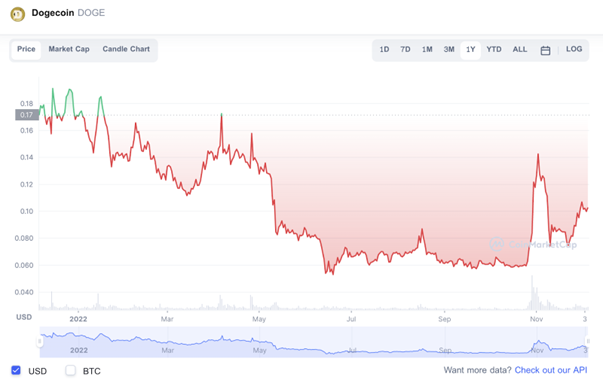
The bull run was triggered by rumors around Dogecoin’s integration into the Twitter payment system, which also worked out well for other popular meme coins like Floki Inu and Tamadoge.
10. FTX Bankruptcy Sets Back the Industry
The worst tragedy to befall the crypto industry this year has been the FTX bankruptcy. Or, is it the LUNA crash? It’s arguable. Despite the number of catastrophes that were thrown at the industry this year, the FTX fall didn’t fail to shock anyone. As one of the world’s largest crypto exchanges came down, so did most of the market.
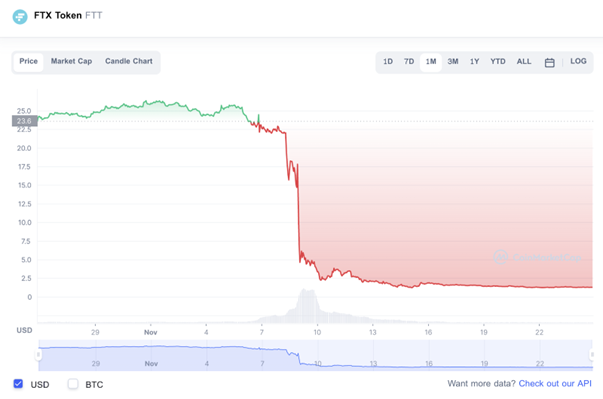
While the industry has seen exchange collapses in the past, like in the case of Mt.Gox, FTX hit harder. Not just in value. The psychological damage was bigger, considering the influence held by then CEO Sam Bankman-Fried. FTX was a credible crypto exchange that won a large community in a short space of time owing to its creative approaches to making crypto more profitable and accessible. For example, FTX was known for its high-profile partnerships and sponsorships, which included Tom Brady and Steph Curry, to name just a few.
A report published in early November revealed that Almeda Research, the sister company of FTX co-founded by Bankman-Fried, was in a poor financial position. More importantly, most of the company’s holdings are in FTX. The lack of transparency and poor management of the FTX ecosystem set off the market, and the rest is history.
FTX paused withdrawals on Nov 8 and FTX filed for bankruptcy on Nov 12. bankman-Fried resigned from his position as the CEO of FTX on the same date.
Is 2022 the Worst Year in Crypto History?
Downturns and crashes are not new in crypto. The market has a history of surviving them regardless of how hard it has been hit. Apart from internal crashes, the general slowdown in the global economy has also affected the market. Due to the persistent inflation and energy crisis caused by the war, there is little flow of investments to crypto. The volatile nature of crypto makes it a poor investment in times of crisis.
Although industry experts like Binance CEO Changpeng Zhao believe that the crashes have set back the industry for a few years, they also think that the tragedies will drive the industry in a better direction. According to Ethereum founder Vitalik Buterin, the bearish sentiments and insolvencies underscore the importance of decentralization.
Sooner or later, the market will get back on track. But it goes without saying that decentralized projects that focus on utility rather than hype will dominate the market in 2023 and beyond. The industry can move to a sustainable path only if it continues to drive innovation. In essence, 2022 is not the worst year in crypto history, but the most eye-opening.
Which Cryptocurrencies to Buy in a Utility-Driven Crypto Market?
Which cryptocurrencies will reward investors in a utility-driven market? Here are our top picks, after analyzing the resilience of their white paper, roadmap, and tokenomics.
1. IMPT
On top of our list is IMPT, the green cryptocurrency that is closing in on its presale sell-out. IMPT introduces a large Web3 ecosystem dedicated to carbon offsetting and climate action. It makes this possible through three products, primarily.
The first of these is a carbon marketplace powered by NFTs. Basically, the platform converts carbon credits into NFTs for increased transparency. That translates to fewer incidents of double spending and fraud in the carbon market. Anyone can buy, sell, and retire carbon credits on the IMPT carbon marketplace. This includes both voluntary and mandatory participants – businesses and individuals.

The next product from IMPT is a shopping application featured by first-of-its-kind carbon credit incentivization. How does it work? Whenever you buy products from environmentally-responsible brands via the shopping application, your account accrues carbon credit rewards. You can later convert these IMPT token rewards into NFT carbon credits on the IMPT marketplace. Leading global retailers have partnered with IMPT to bring the platform into action. They will allocate a percentage of their sales margin to the carbon program, as part of cultivating positive brand recognition.
The third IMPT product is a social platform where friends, family, and businesses can track their contribution to climate action. IMPT’s bespoke scoring system allows you to understand how effective your contributions are and how they fare against other platform users.
You can either sell your carbon credits on the IMPT marketplace to other users or retire them to offset your carbon footprint. When you retire a carbon credit, you earn specially designed NFT artwork in exchange. The creative features dedicated to improving the efficiency of climate action explain why the IMPT presale is fast selling out.
According to the latest news, the token is gearing up for its debut exchange listing on 13 Dec 2022, which will likely take the token price 10X-15X higher.
Buy IMPT
2. Trust Wallet token
Another cryptocurrency that has defied the market downturns this year is Trust Wallet Token. The native token of the Trust Wallet garnered wide traction after the FTX collapse. The tragedy proved that crypto assets are unsafe with centralized exchanges, no matter how credible they seem.

Trust Wallet allows you to buy, store, collect, exchange, and earn crypto and NFTs. It caters to more than 25 million crypto users across the world. Unlike centralized exchanges and wallets, Trust Wallet doesn’t collect any personal data from users. It allows only the owner to access their wallet. You can use the wallet to find your favorite decentralized apps, without switching tabs.
Decentralized applications like Trust Wallet that bring more security and credibility to the industry will be at the forefront of the crypto revolution in the coming years.
3. Dash 2 Trade
Another good example of a utility-rich crypto token is D2T, the native token of Dash 2 Trade. The advanced crypto trading and intelligence platform helps the user get a focused look into the market with the help of relevant data points. Rather than inundating them with jargon and metrics, it provides insights that can have an actual impact on the profitability of a portfolio.
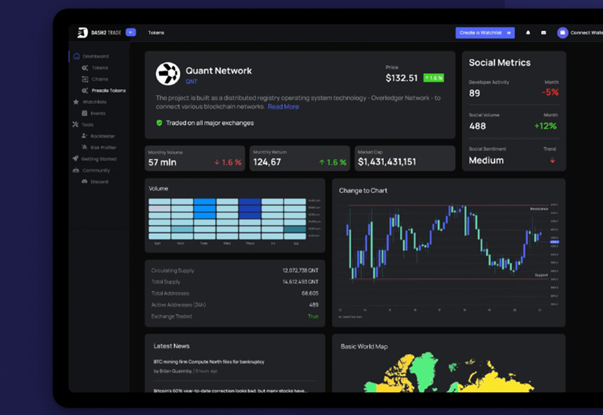
Dash 2 Trade dashboard
Some key features of Dash 2 Trade include advanced trading signals, predictions, social analysis, a custom-made scoring system for presales and ICOs, independent technical indicators, auto trading API, risk profiler, presale listing alerts, and on-chain analytics, to name just a few.
Buy Dash 2 Trade
4. Bloktopia
Bloktopia needs no introduction. The virtual skyscraper is one of the most popular emerging projects on Twitter, with 352.7K followers at the time of writing. It is made of 21 levels, in recognition of 21M Bitcoin.
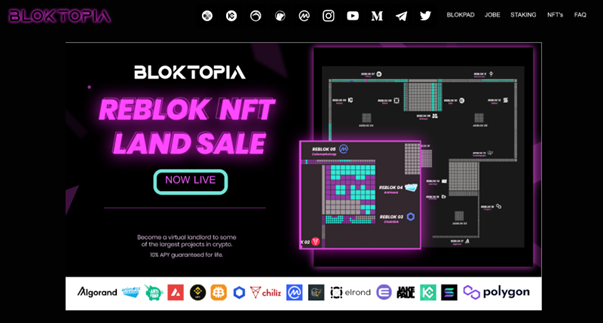
The project aims to become a central hub for the growing Web3 community in the coming years. This is made possible by hosting a one-stop station for crypto information and immersive content. It also allows ‘Bloktopians’ to generate income through real estate ownership, advertising for brands and businesses, playing games, building networks, etc.
The metaverse, built using an advanced real-time 3D Creation Engine, is expected to be nothing short of a visual treat.
5. Calvaria
Calvaria is the only dedicated play-to-earn project on the list. Since the market is flooded with sub-par blockchain gaming projects, we were picky. If you’re a fan of popular blockchain battle card games like Gods Unchained and Splinterlands, Calvaria won’t fail to impress you. The battle card NFT game explores the creative possibilities of the afterlife with an engaging narrative and storyline.
The advanced gameplay on Calvaria caters to both crypto and non-crypto users., with the help of free-to-play and play-to-earn versions.

Calvaria’s gaming ecosystem also comes with a gamified staking platform with multiple pools, a scholarship system, an in-game store where you can buy or sell Calvaria assets, and a DAO. At the time of writing, Calvaria is inching toward the end of the fifth stage of its presale, after witnessing large buyer demand.





